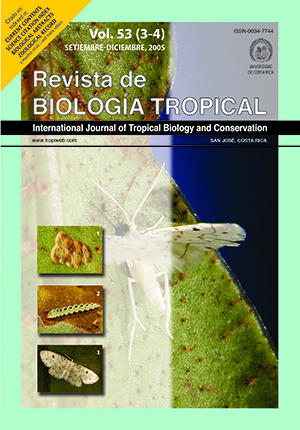Abstract
The chemical composition of the essential oils from leaves and wood of Ocotea brenesii Standl. growing wild in Costa Rica was determined by capillary GC/FID and GC/MS. From the leaves, 64 compounds were identified, corresponding to 85.9% of the oil, and from the wood 57 compounds were identified corresponding to 69.0% of the oil. The major constituents identified in the leaf oil were α-copaene (21.1%), δ-cadinene (9.2%), spathulenol (7.3%), globulol (5.6%) and β-caryophyllene (5.2%). The major constituents of the wood oil were α-copaene (6.6%), caryophyllene oxide (6.3%), β-caryophyllene (6.1%) and humulene epoxide (4.6%).References
Adams, R.P. 1995. Identification of Essential Oil Components by Gas Chromatography/Mass Spectroscopy. Allured, Carol Stream, Illinois, USA. 475 p.
Adams, R.P. 2001. Identification of Essential Oil Components by Gas Chromatography / Quadrupole Mass Spectroscopy. Allured, Carol Stream, Illinois, USA. 462 p.
Brooks, C.J. W. & M.M. Campbell. 1969. Caparrapi oxide, a new sesquiterpenoid from caparrapi oil. Phytochemistry 8: 215-218.
Bruni, R., A. Medici, E. Andreotti, C. Fantin, M. Muzzoli, M. Dehesa, C. Romagnoli & G. Sacchetti. 2004. Chemical composition and biological activities of Ishpingo essential oil, a traditional Ecuadorian spice from Ocotea quixos (Lam.) Kosterm. (Lauraceae) flower calices. Food Chem. 85: 415-421.
Burger, W. & H. van der Werff. 1990. Lauraceae. In Flora costaricensis. Fieldiana, Bot., n.s. 23: 1-129.
Castro, O.C. 1993. Chemical and biological extractives of Lauraceae species in Costa Rican tropical forests, pp. 65-87. In K. R. Downum, J. T. Romeo & H. A. Stafford (eds.). Phytochemical Potential of Tropical Plants. Plenum, New York, New York, USA.
de Díaz, A.M.P., P.P. Díaz & P. Joseph-Nathan. 1991. C6- C3 and C6C1 metabolites from the essential oil of the wood bark of Ocotea caparrapi. Rev. Latinoamer. Quím. 22: 60-62.
Franca, N.C., A.M. Giesbrecht, O.R. Gottlieb, A.F. Magalhães, E.G. Magalhães & J.G.S. Maia. 1975. Chemistry of Brazilian Lauraceae. Part 32. Benzylisoquinolines from Ocotea species. Phytochemistry 14: 1671-1672.
Gottlieb, O.R. 1974. Lignans and neolignans. Rev. Latinoamer. Quím. 5: 1-11.
Gottlieb, O.R. & M.T. Magalhães. 1960. Physiological varieties of Ocotea pretiosa. II. Perfum. Essent. Oil Rec. 51: 18-21.
Gottlieb, O.R., M. Fineberg and M.T. Magalhães. 1960a. Physiological varieties of Ocotea pretiosa. III. Perfum. Essent. Oil Rec. 53: 219-221.
Gottlieb, O.R., M. Fineberg & M.T. Magalhães. 1960b. Physiological varieties of Ocotea pretiosa. IV. Perfum. Essent. Oil Rec. 53: 299-301.
Gottlieb, O.R., M. Koketsu, M.T. Magalhães, S.M.J. Guilherme, P.H. Mendes, A.I. Da Rocha, M.L. Da Silva & V.C. Wilberg. 1981. Óleos esenciais da Amazônia VII. Acta Amazonica 11: 143-148.
Haber, W.A., W. Zuchowski & E. Bello. 1996. An introduction to Cloud forest trees: Monteverde, Costa Rica. La Nación (newspaper), San José, Costa Rica. 204 p.
Ishige, M., M. Motidome, M. Yoshida & O.R. Gottlieb. 1991. Neolignans from Ocotea catharinensis. Phytochemistry 30: 4121-4128.
López, J.A., W. Barillas, J. Gómez-Laurito, F.T. Lin, A.J. Al-Rehaily, M.H.M. Sharaf & P.L. Schiff Jr. 1995. Aporphine alkaloids of selected species of Nectandra and Ocotea. Planta Med. 61: 589.
López, J.A., W. Barillas, J. Gómez-Laurito, F.T. Lin, A.J. Al-Rehaily, M.H.M. Sharaf & P.L. Schiff Jr. 1996. Aporphine alkaloids of Ocotea brenesii. Int. J. Pharmacog. 34:145-147.
Lorenzo, D., I. Loayza, L. Leigue, C. Frizzo, E. Dellacassa & P. Moyna. 2001. Asaricin, the main component of Ocotea opifera Mart. essential oil. Nat. Prod. Lett. 15: 163-170.
McLafferty, F.W. 1993. Registry of Mass Spectral Data. Wiley, New York, New York, USA. Menut, C., J.M. Bessière, M. Said Hassani, G. Buchbauer & B. Schopper. 2002. Chemical and biological studies of Ocotea comoriensis bark essential oil. Flav. Fragr. J. 17: 459-461.
Mors, W.B., M.T. Magalhães & O.R. Gottlieb. 1959. Physiological varieties of Ocotea pretiosa. I. Perfum. Essent. Oil Rec. 50: 26-27.
Reynolds, T. & G. Kite. 1995. Volatile constituens of Ocotea porosa (Phoebe porosa) Mez. J. Essent. Oil Res. 7: 415-416.
Terreaux, C., M. Maillard, K. Hostettmann, G. Lodi & E. Hakizamungu. 1994. Analysis of the fungicidal constituents
from the bark of Ocotea usambarensis Engl. (Lauraceae). Phytochem. Anal. 5: 233-238.
van der Werff, H. 2002. A synopsis of Ocotea (Lauraceae) in Central America and Southern Mexico. Ann. Missouri Bot. Gard. 89: 429-451.
Comments

This work is licensed under a Creative Commons Attribution 4.0 International License.
Copyright (c) 2005 Revista de Biología Tropical






